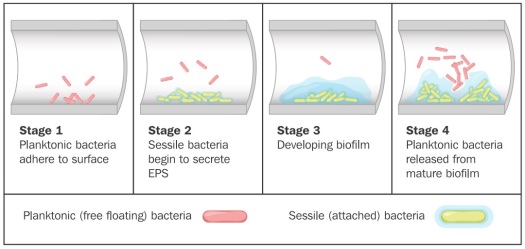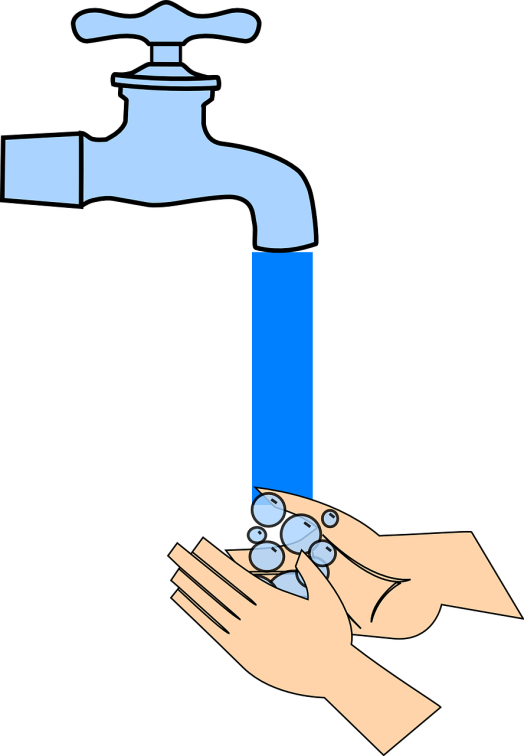
Many businesses and buildings are suffering from an enforced shutdown, but these notes apply equally to any building or business that stops its activities for one week or more. This could include educational establishments out of term time, companies who have a shutdown in holiday seasons as well as the enforced shutdown caused by the COVID-19 pandemic.
What causes the problem
Stagnant water
Water that can stagnate may well encourage bacteria to grow. This could give rise to increased biofilms as well free living bacteria which may include pathogenic bacteria such as Legionella and Pseudomonas aeruginosa. Stagnation could occur in hot and cold water systems, toilet cisterns, irrigation systems, unused rooms such as hotel or student bedrooms, cooling systems and cold water storage tanks.
Low water use
You may have reduced numbers working in your buildings or using the water in your buildings such that the consumption of water is much less than the system was designed to support. This can lead to low flow areas where again bacteria can be encouraged to grow and thrive. Water softeners and other pre-treatment plant, including filtration, could allow water to reside too long in the vessel which as well as encouraging bacteria could cause channelling through a water softener resin resulting in a shortened supply of softened water.

Ways to manage water
Have a Water Safety Plan or Written Scheme.
This pre-written plan should have allowed for the limited use of water and provide you with site specific ideas on how to manage the reduced flow of water. If you haven’t created a Water Safety Plan, then now is the time to do so. Consider all possible uses of water on site, not just the hot and cold water system and cooling systems. It may be that you have other sources of water on site such as drinking water dispensers or use water in equipment in a medical environment. Advice on Water Safety Plans and Written Schemes can be found in the UK’s HSG 274 and HTM0401 and in the WHO’s guidance on managing Legionella. In 2020 there will also be a new British Standard, BS8680, on writing Water Safety Plans.

Have a flushing regime.
A way to ensure that you manage no or low flow is to have a flushing regime, this means that once per week you run every outlet on a hot and cold water system and flush all toilets, it also may mean running recirculating pumps on process waters and cooling water systems.
If the building is a high risk building such as a healthcare site or aged persons home then the flushing should be twice per week and if it is an Augmented Care ward this flushing should be daily.
How long flushing should take depends on your system, the official advice is until the outlet water temperature equilibrates with the supply water (hot water or incoming cold water mains) however this can also depend on the layout of the water system. It is a good idea to start flushing outlets closest to the source and then move away from the source, in this way the “fresh” water will follow you and therefore will not take so long to flush.

Clean outlets
Outlets with flow straighteners or aerators can allow water to stagnate within their structures and therefore these terminal devices should be removed and cleaned thoroughly regularly wherever possible. Don’t forget when cleaning outlets to use a clean “cloth” between outlets, do not go from outlet to outlet with the same “cloth” as this can spread bacteria between outlets.

Ensure your secondary biocide is operational
If you use a secondary biocide in a hot and cold water system then ensure it is operational. However, bear in mind that if you are not using water or have low flow then the biocide may not reach the parts you want to protect. Check the level of biocide at the outlets after you have flushed them and consider flushing for longer to draw the biocide to the outlet.
If you use biocides on a cooling system or process water then the same applies, you should run the recirculating pumps regularly (weekly as a minimum) to ensure the biocide is circulated.
Bear in mind how the biocide is controlled, a timed addition of biocide may well keep adding the biocide even though the system being treated is not operational, whether it is hot and cold water or a process system, and so may result in an excess of biocide close to the point of addition. Conversely a redox probe type system may result in insufficient biocide being dosed when you circulate the water. Therefore, you should carry out biocide level checks and adjust the dosing equipment or flushing to suit your set up.
Carry out a disinfection before re-opening
If your system has been stagnant, or had low flow, it may well be you have had bacteria growing in your system. If you have not been dosing a biocide during this time, then you have had no protection.
Consequently, you should seriously consider disinfecting your system before you bring it back online. This would be true for an educational establishment that hasn’t been open during the summer equally as much as to a building “mothballed” due to the COVI-19 pandemic.
Not to carry out a disinfection puts your staff at risk from encountering pathogenic bacteria such as Legionella and Pseudomonas aeruginosa.
Hospital Augmented Care
Under the current situation due to Covid-19 where wards are being re-purposed to act as Augmented Care wards which were not previously designated as such, this will change the requirements for water management, so my recommendation during this period is as follows:
1. Where access to water systems is not restricted, carry out Legionella and Pseudomonas testing, and any required remedial measures as normal.
2. Where estates staff encounter restricted or no access to water systems due to the risk of cross-infection it would be unreasonable to ask nursing staff to collect water samples and they would be unable to undertake remedial measures, so I would propose fitting a long life (preferably 3 months) Point of Use filter to each hot and cold water outlet, including showers. This will provide a source of bacteriologically filtered water without the need to consider testing or remediation until the filter needs changing. As changing filters is relatively simple and would be infrequent where long life filters are used, this could be undertaken by nursing staff under instruction from estates staff.

Do not forget the advice from the Health & Safety Executive that companies still have a duty to their staff during the COVID-119 pandemic and therefore the legislation and guidance regarding Health & Safety remains in place.
If you would like to discuss any of the issues raised in this article, please contact Collaton Consultancy who will be happy to discuss your specific needs in greater detail to help you formulate a plan for this situation.
EMAIL US NOW